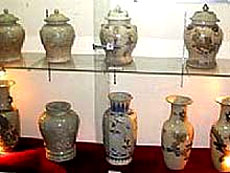 Ngan
Nam Gom Viet (A Thousand Years of Vietnamese Ceramics) features 260
artefacts that traces the development of national traditional ceramics
during the reigns of the Ly, Tran, Earlier Le, Mac, Le Trung Hung
(Later Le), and Nguyen dynasties.
Ngan
Nam Gom Viet (A Thousand Years of Vietnamese Ceramics) features 260
artefacts that traces the development of national traditional ceramics
during the reigns of the Ly, Tran, Earlier Le, Mac, Le Trung Hung
(Later Le), and Nguyen dynasties.
The Ly and Tran dynasties, who reigned from the 11th to 15th
century, were famous for jade-glazed bowls and tea pots, and glaze
ceramics produced in different shades including green, white and brown.
The traditional vocation flourishes to this day in the craft
villages of Bat Trang and Phu Lang in Hanoi and Bac Ninh Province,
respectively.
White-and-blue glazed ceramics having a high, brown base with
underglazed cobalt floral decorations were produced from the 15th to
18th century during the Le Dynasty as well as the Mac and Le Trung Hung
dynasties.
The Nguyen Dynasty in 19th and 20th century, the last of the feudal
rulers in Vietnam, saw the development of Vietnamese ceramics in
southern region.
Lai Thieu in Binh Duong Province, Bien Hoa in Dong Nai Province and
Cay Mai in HCMC’s Cho Lon (Big Market) emerged as famous centres of
ceramic production.
The exhibition is being organised by the HCMC Museum, Vietnam
History Museum in HCMC, HCMC Fine Arts Museum, Southern Women’s Museum,
HCMC Antiques Association and private collectors to celebrate the
1,000th anniversary of Hanoi.